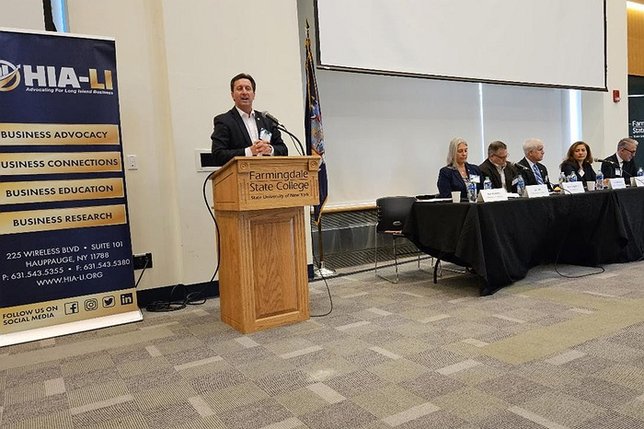A new report spells out a five-part, workforce development strategy that aims to enhance the long-term competitiveness and vibrancy of the Long Island economy. The report was released Friday at an HIA-LI “Workforce Development Conference and Scholarship Awards” event held at Farmingdale State College.
HIA-LI, one of the recognized voices for Long Island business, joined with the Suffolk County Industrial Development Agency and the Workforce Development Institute to commission the publication of “Innovating the Talent Pipeline: Strategies for Workforce Development in the Long Island Innovation Park at Hauppauge.”
The action strategies contained in the report are designed to help the private sector, government, and educational institutions sharpen their focus on training-related investments that will go furthest in generating sustained returns for Long Island businesses.
The 54-page report includes a strategic analysis of the area’s long-term workforce needs as well as an action plan for attracting and retaining a properly skilled workforce within the business park and across the region.
The Long Island Innovation Park at Hauppauge is the largest industrial park in the Northeast with more than 55,000 employees, 1,300 companies, and an economic output of more than $13 billion. HIA-LI serves as a steward for the park.
The report was written by James Lima Planning + Development, a New York City-based planning, real estate, and economic advisory firm. The company conducted online surveys of 34 Long Island employers between July and September of this year. Survey questions focused on the businesses’ skill and talent attraction/retention needs. Eighty-eight percent of respondents employ 50 or more people. Three-fifths of the respondents were located in the Long Island Innovation Park at Hauppauge.
Much of the report presents findings specific to the Innovation Park in respect to skill gaps, training resources, and strategies for the attraction and retention of talent. The analysis also aims to align local and regional workforce development efforts with technological market and societal changes.
In addition to evaluating strategies best suited for workforce retention and attraction, the study analyzed three categories of employee skills: technical skills, software skills, and interpersonal skills.
“Now more than ever, businesses are recognizing the importance of investing in the skills, knowledge, and adaptability of their workforce,” said Terri Alessi-Miceli, President and CEO of HIA-LI. “This visionary study spells out a workforce development strategy that can underpin the long-term resilience of the Long Island business sector.”
“The Suffolk County IDA's role of attracting and retaining new businesses hinges on the ability of our region to produce a workforce that is ready to meet the skill sets required by today’s growing industries," said Kelly Murphy, Acting Executive Director of the Suffolk County Industrial Development Agency and a member of the HIA-LI board. “This survey is extremely impactful as it helps to determine where some of the knowledge and skills gaps exist so they can be addressed. A diverse and talented workforce is what sets our region apart and this study will bolster our position into the future.”
“Long Island’s academic institutions have a critical role to play in nurturing and sustaining the health of our area’s businesses,” said Dr. Edward Bonahue, President of Suffolk County Community College and a member of the HIA-LI board. “Suffolk County Community College is already collaborating with HIA-LI in the area of workforce development, and this report will help all stakeholders magnify our success in this critical area.”
“This analysis provides valuable insights into the present state of skill training and the challenges related to attracting and retaining workers both at the Innovation Park and across the region,” said Carol A. Allen, President and CEO of People’s Alliance Federal Credit Union and Chairperson of the HIA-LI board. “When we maximize the impact of our workforce development initiatives, it’s a win-win for both employer and employees.”
“This report reminds us that we can propel sustainable economic growth for Long Island by prioritizing workforce development and by fostering innovations in the way we attract and retain talent,” said Rich Humann, President and CEO of H2M architects + engineers and a member of the HIA-LI board. “We call upon businesses, government, and academic institutions to look closely at the report's recommendations – and take prompt action to implement them.”
“Innovating the Talent Pipeline” enumerates five recommendations for enhancing Long Island’s strategic approach to workforce development:
The report’s first recommendation is to mount an island-wide “Access and Awareness” campaign to engage local employers, training and resource providers, and local community-based organizations. The campaign would promote such programs as adult English classes at local libraries, Suffolk County Labor Department career support, and Farmingdale State College’s job fairs.
The second recommendation is to strengthen industry-academia partnerships. This initiative would be undertaken by trade associations, employers, schools, and training providers. The program would focus on project-based learning, digital and AI tools, emerging industry processes and materials, and manufacturing sector best practices.
The third recommendation is to make the business case for intra- and cross-sector collaborations. This initiative would be led by business groups, employers, regional interest groups, government agencies, and nonprofit intermediaries. These partners can promote programs involving manufacturing sector best practices, foreign language support, and software training.
The fourth action step is to “foster a pathway and culture for learning and advancement.” This strategy would promote such programs as mentee/mentor initiatives as well as such branded learning programs as Pryor Business Training, Relias Academy, and KnowledgeWave.
The fifth and final recommendation is to promote more affordable and attractive communities on Long Island. Action would be taken by private industry and regional trade associations, government agencies, and community groups. They would advocate, for example, for the expansion of workforce housing and transit-oriented development.










